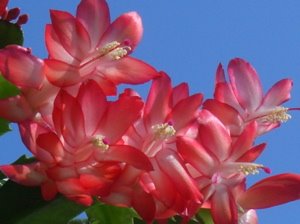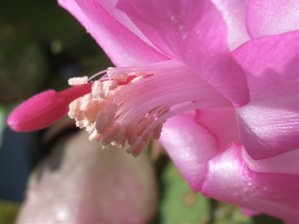crab cactus or christmas cactus (schlumbergera truncata)
 There seems to be some confusion about the name of these cacti. The California gardener's bible, the Sunset Western Garden Book
There seems to be some confusion about the name of these cacti. The California gardener's bible, the Sunset Western Garden Book This type of cacti is also known as forest cacti, and in their natural home the forest cacti are attached to trees in woodlands and jungles, and so it is not surprising that they are so different in form and care requirements from the spine covered desert cacti. The only exception to this is the Rat's Tail cactus, which looks like and should be treated like a desert cactus. The typical forest cactus has leaf-like stems and a trailing growth, making it suitable for hanging baskets. A few such as Rhipsalis are grown for their stem form but their main attraction is their flowers. The most spectacular group are the Epiphyllums, with their fragrant saucer-size blooms.
This type of cacti is also known as forest cacti, and in their natural home the forest cacti are attached to trees in woodlands and jungles, and so it is not surprising that they are so different in form and care requirements from the spine covered desert cacti. The only exception to this is the Rat's Tail cactus, which looks like and should be treated like a desert cactus. The typical forest cactus has leaf-like stems and a trailing growth, making it suitable for hanging baskets. A few such as Rhipsalis are grown for their stem form but their main attraction is their flowers. The most spectacular group are the Epiphyllums, with their fragrant saucer-size blooms. Schlumbergera truncata originates from Brazil. It has short tubed 3 inch long, scarlet flowers with spreading, pointed petals from late fall through winter. Many varieties are sold in white, pink, salmon, pink and orange.
Christmas Cactus Facts
Bloom time: October through December.
Exposure: Moderately bright light (diffused sunlight) is preferred, near a sunny window indoors, but not exposed to direct sunlight.
Soil: Moderately moist yet well drained soil.
Temperature: Cool/moderate temperatures are ideal. 60-70 degF (15-21 degC) daytime, and 55-65 degF (13-18degC) nights.
Growth rate: Slow.
Water: Water thoroughly when the surface is dry to the touch, mist the leaves frequently, especially indoors with central heating.
Fertilizer: Feed with liquid fertilizer every 7-10 days during growth and bloom.
Size: S. truncata grows to 1 foot high and wide.
These plants are very pretty when they are in full flower and make wonderful gifts as indoor plants, or on a patio in a hanging basket. The main key to success is to remember that flowering is affected by temperature and light. Sudden temperature changes, too high or too low, may result in inconsistent flowering or inhibit flowering altogether.



0 Comments:
Post a Comment
<< Home